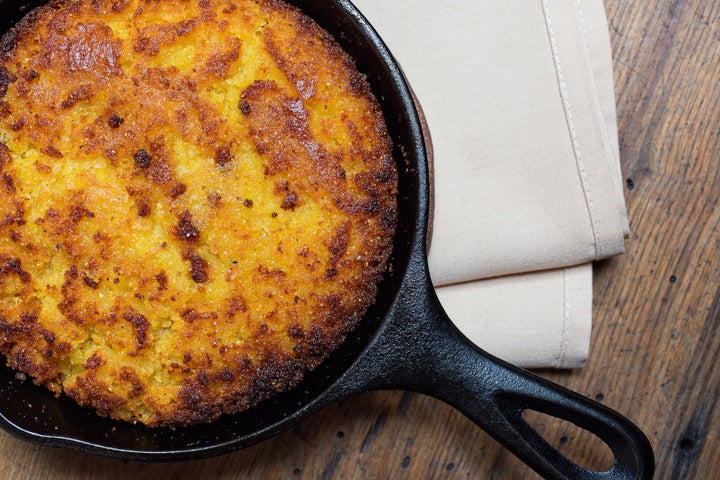
Like barbecue, pizza or, even, apple pie, variations of cornbread recipes are treated like gospel in different regions. The way one makes or prefers cornbread serves as a cultural signifier, essentially communicating, “You’re one of them, or one of us.”
A survey of the cornbread practices across country, and new information about how heirloom varieties of corn are reviving history reveals a complex and sometimes surprising backstory — and one that could make you question your own cornbread credibility.
Let’s start in the time before cornbread. Native Americans began cultivating corn millennia before the first Europeans arrived on the shores of the New World. Dating back to the Olmec and Toltecs, humans began domesticating teosinte, a small, wild grass that looks like wheat with much larger kernels than your average sweet corn.
“Going back to Central America, you can watch the domestication of foods like corn, beans and squash move northward thousands of years ago,” says Sean Sherman, founder and CEO of The Sioux Chef. “I don’t think people think about the history much.”
By the time Europeans arrived on the Eastern seaboard of the United States, massive agricultural civilizations had long been established by Native Americans, who cultivated a wide array of corn varieties.
With that corn, came cornmeal and a range of corn-based fare. Early on, before the Maya, residents of Central America figured out how to nixtamalize corn. Kernels were soaked in an alkaline solution (water and ash). Through that process nutrients like niacin become soluble, allowing the body to absorb more vitamins and fend off nutrient deficiencies like pellagra.
That process has created pozole in the Southwest and hominy in the Southeast.
According to Crescent Dragonwagon, author of The Cornbread Gospels, tortillas, made from nixtamalized corn (or masa) were essentially the first form of cornbread.
But recipes and traditions grew from there. The most basic formulas involved rehydrating cornmeal into a soft substance, like polenta or grits, with cooking fat and some seasoning (ash was the original flavor enhancement for Native Americans) before drying and slicing into bread.
“The Iroquois still have bean and white cornbread,” says Sherman.
That Iroquois white corn was just one of hundreds, if not thousands of corn varieties cultivated across the continent in the pre-contact days. As corn production became increasingly commercialized, many of those heirloom varieties fell out of favor. Flavor was lost.
Today, they’re being brought to life by a small but growing community of chefs, farmers and activists. They are bringing cornbread back to its ancient, flavorful roots.
The Iroquois White Corn Project is reviving the 1,400-year-old variety that sustained the 4,500 Seneca people who lived in the town of Ganondagan, outside of Rochester, in the 17th century.
Sherman, through his company, has been working to revive indigenous food systems throughout parts of North America, working with Seed Savers Exchange and Anson Mills to revitalize culturally and regionally appropriate seeds with Native American tribes. “We still have hundreds of varieties of corn still out there today,” he says. “These heirloom varieties are extremely sacred, because they’re so rare.“
Today, one of the best known heirloom varieties, and one of the most prized by chefs, is Jimmy Red Corn, an open-pollinated dent corn first cultivated by Native Americans (which tribe is unknown). It was brought to South Carolina in the early 1900s, but it fell out of favor when industrial agriculture arrived in the area. In the early 2000s, it was in danger of going extinct.

Celeb chef Sean Brock brought it back to life.
With the help of James Island–native Ted Chewning, who gave Brock his first ears, Glenn Roberts of Anson Mills and professor David Shields of the University of South Carolina, Brock ushered Jimmy Red back into commercial production. It is now on restaurant menus all throughout the Lowcountry and it’s what makes Brock’s cornbread so famous.
“I’d never had cornbread like that before,” says Brock. “Freshly milled out of the field into the skillet, when that cornbread comes out of oven, you crack it open and put your nose into it, you’re transported to another universe, transported to grandma’s table and every table in the South. It’s incredible stuff.”
Growing up in Virginia, cornbread is a huge part of Brock’s identity. He has Jimmy Red tattooed on his arm and the dish was a huge driver in his desire to open Husk, one of the restaurants responsible for putting Southern fare on the international map. “Growing up, I can’t recall a meal where we didn’t have cornbread,” says Brock. “I think a generation ago, it was on every table every night every day.”
That intimacy is partly what makes cornbread such a hot topic of debate. It’s a defining dish for Southern cuisine, but there are actually three distinct styles of cornbread in the United States. Each one influenced by regional climate, economics and demographics.
In the South, it started with basic hoe cakes or ash cakes, just a mix of cornmeal and water cooked outdoors over coals on the back of a hoe by slaves in the field.
The big house version was richer, generally a quick bread made with cornmeal, butter, eggs and some form of dairy, “More likely cultured buttermilk than sweet milk because there was no refrigeration. Fermentation was how you preserved foods in hotter climates,” says Dragonwagon.
Within the South, there are cornbread micro regions and family recipe variations, but the rule of thumb is that it’s made with mostly white cornmeal, buttermilk, some kind of fat (bacon drippings, butter or oil), an egg or two and no wheat flour or sugar, often emphatically no sugar, poured into a skillet with sizzling hot butter or bacon fat on top of the stove, finished in the oven. Some versions lack eggs, especially when being used for dressing or stuffing.
Brock uses buttermilk, lard, one egg, baking soda, baking powder and a bit of cracklin’.
Cornbread muffins are not common and, while there are exceptions to the rule, Southern cornbread tends to be drier and more savory than other styles, designed to be consumed with beans, covered with melted butter or, as was Brock’s family’s morning ritual, soaked in buttermilk like cereal.
Where cornbread is a significant cultural identifier for many Southerners, most Northerners don’t infer much meaning from the dish — except Rhode Islanders. Residents of the Ocean State are so fanatical about their cornbread or johnnycakes that there is a law on the books specifying the correct spelling of johnnycakes — it’s illegal to spell jonny with an “h” on the menu.
There are two styles of johnnycakes in the state, both of which are made from white cornmeal, preferably Whitecap flint corn, formed into round, pancake-like discs.
On the west side of the Narragansett Bay, johnnycakes are thick and heavy, almost reminiscent of tamale dough, and fried.
The ones toward the east, Newport County–style are thin and lacy, griddled, more like a pancake/crêpe hybrid.
Throughout the rest of the industrial north, where corn was often derided, settlers thinned out their cornbread with wheat or rye flour. Yankee-style cornbread, developed by the sweets-loving Dutch who first colonized New York, is sweeter, almost like cake. It’s most frequently made from a 50/50 blend of yellow cornmeal and flour, sugar, sweet or regular milk, leavened with an egg, baked in a cold casserole dish or muffin tin.
These variations in cooking techniques were driven by weather. In the South, where the temperature is often balmy, cooks wanted to limit the heat coming from their oven, so it made more sense to get a skillet screeching hot on the stove, before transferring the pan to an oven. “You wanted it quick and hot, and then to let it die down,” says Dragonwagon.
Up in the frigid North, wood ovens were used to warm the home much of the year. There, cooks poured batter into room temperature pans, cooking the bread at a low temperature for a longer period of time. “This combination of cooking method and ingredients mean that Yankee cornbread is more cakey, like a muffin and Southern cornbread has a distinct texture, grittiness with a nice crunch to the crust.”
The two styles are blended together in African-American cornbread, most likely a result of the Great Migration, when more than six million Southerners escaped to the North. The batter is often quite sweet with a touch of sugar and a blend of cornmeal and flour (generally more cornmeal), cooked Southern-style in a skillet, finished in the oven. It has the grittiness and crunchy exterior found in the South, but with a light, moist texture and a slightly nuanced flavor profile. “That has always been my ideal cornbread,” says Dragonwagon.
Starting about 20 or 30 years ago, a new style of cornbread started to emerge from the Southwest, basic cornbread somewhere on the spectrum between Yankee and Southern with flavorful embellishments like jalapeño, cheese, garlic, finely chopped onion or extra butter or coarse sea salt sprinkled atop. “It’s Tex-Mexy, not a distinct kind,” says Dragonwagon. “It’s like somebody took family cornbread recipe and started adding stuff.”
While that elaborate transition seems like the obvious evolution of one of the continent’s oldest dishes, it’s kind of funny that the real trend in cornbread has been looking back to the distant past.
Over time, Brock — the man who could be credited with cornbread’s current moment — has softened his strict no-sugar, no-flour cornbread dogma. But there’s one ingredient for which he will not deviate: He refuses to use grocery store cornmeal when he’s cooking abroad. “When I’m faced with that dilemma, which I’ve faced many, many times, I cannot bring myself to cook something that tastes like the cardboard box it came it.”
Instead, he vacuum seals Jimmy Red and smuggles it in from all over the world.
For him and many others, cornbread is a statement. You’re going to be judged by what you put on the table. Know your history, choose your ingredients well, and you have a chance at earning respect.